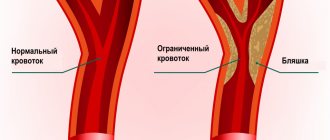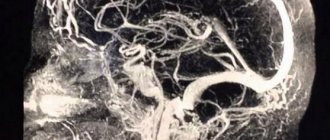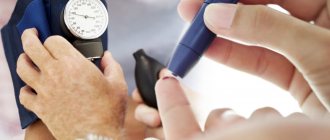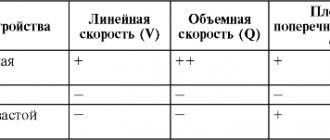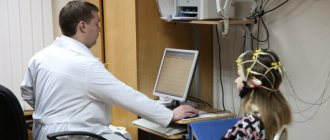Drugs that improve blood circulation in the brain are indicated for disorders of various origins. There can be many causes of problems with cerebral vessels, and the main ones are the following:
- atherosclerosis;
- stroke;
- head injuries (craniocerebral);
- osteochondrosis;
- systemic diseases;
- hypertension.
All of the above pathologies are accompanied by dizziness, memory loss, headaches and require mandatory treatment. Therapy is especially relevant after an ischemic stroke.
Who may need vascular medications?
In early childhood, changes in blood flow in the brain are a consequence of perinatal encephalopathy, birth trauma, hypoxia during childbirth, and pressure drop during cesarean section. If a treatment plan is drawn up correctly, the child’s condition will normalize within 2-3 years. If the baby has cerebral palsy and other serious diseases, he will have to take vascular medications for the rest of his life.
School-age children grow quickly, and vascular medications may be needed due to the increased workload.
In adults, cerebral circulatory disorders are even more common - due to heart disease, osteochondrosis, ischemia, thrombosis, injuries, and operations.
In older people, the blood vessels of the brain suffer from atherosclerosis - blockage of the arteries with plaques. All of these categories of patients have indications for taking vascular drugs.
Manifestations of the disease
With atherosclerosis, specific symptoms arise, and at each stage of development of the pathology they differ.
First stage
At the initial stage, when the walls of the arteries absorb lipid compounds, there are no obvious symptoms of the disease. The pathology progresses, as there are no prerequisites for seeing a doctor. If the disease is identified and treated at this stage, dangerous complications can be prevented.
Second stage
Progressing, atherosclerosis of the lower extremities begins to be expressed in:
- not too pronounced, nagging pain in the legs, which intensifies with physical activity or a sudden change in body position and passes quickly;
- a feeling of heaviness that occurs throughout the day;
- pale skin on the lower extremities, good visibility of the choroid plexuses;
- slowing down hair growth.
In the first and second stages, the development of the pathological process can be slowed down with the help of special medications.
Third stage (decompensation)
At this stage, the symptoms are more pronounced, since the lumen of the artery is narrowed. The patient is concerned about:
- constant severe pain in the legs, which becomes unbearable at the end of the day or after physical activity;
- burning sensation of the skin;
- changed color of the skin of the legs: it becomes gray or purple, which is associated with stagnation of blood in the vessels;
- skin itching associated with insufficient nutrition of leg tissues;
- the formation of trophic ulcers, which are initially small in size, but gradually become wider, and then ulcerate and collapse inside the limb;
- weakening of muscles, due to which the patient cannot move normally. Intermittent claudication occurs.
Treatment with drugs in this case does not produce results: surgery is required.
Fourth stage
The severity of symptoms reaches a critical level. The area of trophic ulcers is becoming larger. After some time, gangrene develops. In atherosclerosis, this is a terminal stage requiring urgent surgical intervention.
Calcium channel blockers
These medications are among the most popular among neurologists and therapists. Due to a decrease in the amount of calcium in cell membranes, the vascular walls relax, their lumen expands, and blood flow increases. The amount of nutrients and oxygen reaching the brain also increases. The tone of the veins does not change, which is important for maintaining normal venous outflow. There are a number of proven drugs, as well as new generation drugs.
Which ones are better to choose? The list of the most popular is given in the table.
| Generation | Name of medicine | Group |
| First | Verapamil | Phenylalkylamine derivatives |
| First | Nifedipine | Dihydropyridine derivatives |
| First | Diazem | Benzothiazepine derivatives |
| Second | Isradipin | Benzofurazanil derivatives |
| Second | Plendil | Dihydropyridine derivatives |
Currently, third-generation drugs are being developed that have even fewer side effects and contraindications. The above remedies can also treat arterial hypertension. Vasodilators are contraindicated during pregnancy and lactation.
Antioxidants and antihypoxants
Such medications are always prescribed as part of complex therapy to improve cerebral vascular function. They quickly eliminate the symptoms of oxygen starvation and help strengthen vascular walls. Here is a list of the best medicines:
- Actovegin
(630 rubles). Activates tissue metabolism, eliminates hypoxia, optimizes trophism and recovery processes. The drug is obtained from the blood of animals, therefore, in addition to allergies, it has a small number of side effects. - Mexidol
(470 rubles). It is one of the best antihypoxants, membrane protectors, and nootropics. The medicine is administered intramuscularly or taken in tablet form. It increases the body's resistance to various damaging factors. With long-term use, the medicine somewhat thins the blood and reduces the accumulation of lipids, lowering cholesterol. - Emoxipin
(250 rubles). Antioxidant, stabilizer of cell membranes, reduces vascular permeability. Has a retinoprotective effect. Most often prescribed if cerebral disorders affect the condition of the retina. - Glycine
(40 rubles). This amino acid is a natural brain metabolite, a neurotransmitter, that helps regulate metabolism in brain tissue.
Complamin, Glutamic acid, Picamilon and other antihypoxic and antioxidant agents also improve the functioning of cerebral vessels.
Reasons for the development of pathology
In atherosclerosis of the vessels of the lower extremities, the provoking factor is a violation of lipoprotein metabolism in the body, which is expressed in the inability of the liver to completely process lipoproteins (fatty fractions). As a result, these compounds remain unchanged and enter the bloodstream. Fat fractions settle on the inner walls of the elements of the circulatory system and provoke an inflammatory process.
The causes of disturbances in lipoprotein metabolism, which can lead to atherosclerosis, include:
- systemic metabolic and endocrine abnormalities (diabetes mellitus, thyroid dysfunction, obesity);
- persistent increase in blood pressure, which negatively affects the elasticity and tone of blood vessels;
- abuse of foods rich in animal fats;
- bad habits (smoking, alcoholism) that negatively affect the condition of the arteries;
- sedentary lifestyle;
- increased physical and psycho-emotional stress;
- heredity (features of hormonal levels, immune reactions, lipid metabolism in the body);
- local factors causing occlusive-stenotic damage to the blood vessels of the lower extremities (history of frostbite and leg injuries).
Men suffer from atherosclerosis more often than women. This is explained by the fact that female sex hormones - estrogens - reduce the activity of low-density lipoproteins, which give impetus to the formation of cholesterol plaques.
Vitamins and minerals
The next group of vasodilator drugs for the brain are vitamin supplements that are urgently needed for the normal functioning of blood vessels. Most often, patients are recommended drugs based on nicotinic acid in injections.
The medicine improves the metabolism of nitrogenous substances and carbohydrates, dilates blood vessels, and reduces cholesterol. Nicotinic acid also improves blood microcirculation in the brain and replenishes vitamin B3 deficiency.
The main preparations with vitamins are Nicotinamide, Niacinamide, Nicotinic acid in ampoules.
Rutin is another remedy that strengthens blood vessels. Troxerutin and Ascorutin are made on its basis; they are prescribed against the fragility of small capillaries, to reduce the permeability of vascular walls, as an antioxidant.
Also, patients with vascular diseases are recommended to regularly take tablets with retinol, tocopherol, potassium, selenium, and silicon. For osteochondrosis of the neck and other diseases of the spine, a complex of B vitamins - Neuromultivit, Compligam, Milgamma - is always introduced into the course of therapy.
Diagnostic methods
Atherosclerosis of the leg arteries is diagnosed based on the following studies:
- blood chemistry;
- lipid profile to detect low- and high-density lipoproteins in the blood;
- immunological analysis;
- duplex scanning;
- angiography;
- MRI;
- ECG.
Tests and samples are also performed to identify atherosclerosis of the lower extremities.
One of these methods is to determine the ankle-brachial index. The patient's pressure is measured in the ankles and arms at rest, after which he is asked to walk actively on a treadmill for 5-7 minutes. Then the pressure is measured again. The result is obtained by correlating the highest systolic pressure in the ankle and shoulder area. A value between 0.71 and 0.4 indicates the presence of the disease.
Nootropics
These medications do not act directly on blood vessels, but they improve overall metabolism in tissues, stabilize neurocyte membranes, increase tissue resistance to oxygen starvation, thereby optimizing blood supply to the brain. Nootropics are prescribed even to children, they are indicated for most elderly people, and are used in the complex treatment of osteochondrosis, atherosclerosis, hypertension, the consequences of cerebral palsy, etc.
The cheapest and most accessible are racetams - Piracetam, Nootropil, Lucetam, Phenotropil and others.
The latest generation of drugs includes Cortexin, which is a complex of polypeptides from the animal cerebral cortex. The medicine is injected into the muscle; it is available only in injection form. Price for 10 ampoules - 1300 rubles.
Patients are also given the following injections:
- Cerebrolysin;
- Vinpocetine;
- Cavinton;
- Telektol;
- Bravinton.
Many nootropics have a positive effect on blood composition - they prevent platelets from sticking together, improving blood microcirculation by increasing its fluidity. This helps to avoid thrombosis and other serious complications of vascular pathologies.
Approaches to surgical treatment for atherosclerotic lesions of the legs
If taking medications does not produce results, and also if the lesion is characterized as advanced, surgical treatment of atherosclerosis is required.
Main methods:
- Balloon angioplasty. The essence of the operation is to insert a special catheter with a small balloon into the area of narrowing and then inject pressure here by expanding the balloon. This helps restore patency. The operation is carried out under the control of a video camera and is low-traumatic. Patency of the artery after surgery is maintained for 5 years
- Shunting. This method is used if there are contraindications to balloon angioplasty. A shunt, a kind of implant that restores blood flow by bypassing the affected area, is implanted into the femoral vein. This operation is classified as complex and requires two weeks of rehabilitation after it is performed. A patient who has undergone bypass surgery must regularly take medications (anticoagulants and statins), give up bad habits and control weight.
- Endarterectomy. This is a radical operation that involves direct removal of an atherosclerotic plaque that has completely or partially blocked the lumen of the artery. It is performed under local or endotracheal anesthesia.
Patients who have undergone surgery to treat atherosclerotic disease must always control their weight so that the load on the lower extremities does not increase. To do this, you need to follow a healthy diet and avoid foods rich in “bad” fats. You also need to take medications to improve the rheological properties of the blood.
The sooner the pathology is identified and the sooner the course of treatment begins, the greater the chance of slowing its progression.
The most undesirable outcome of atherosclerosis is tissue death due to impaired blood flow and the development of gangrene. In this case, amputation is required, that is, surgical separation of the limb or part thereof. It all depends on the degree of damage and how timely the treatment process was started.
Medicines for atherosclerosis
If a person is diagnosed with atherosclerosis, treatment with folk remedies or so-called vascular cleansing is not always enough. Atherosclerosis of cerebral vessels is a very serious disease; without treatment it leads to stroke.
The following will help improve blood circulation in this pathology:
- Statins
- Rosuvastatin, Atorvastatin, Lovastatin. Many people have to take these medications for several years; they normalize cholesterol levels and prevent it from depositing in the blood vessels. Unfortunately, statins have a bad effect on the liver and other internal organs and can cause a number of side effects. - Fibrates
- Fenofibrate, Clofibrate. They increase “good” cholesterol while reducing “bad” cholesterol. The course usually lasts up to 2 months, then take a break. - Other means - bile acid sequestrants
. These medications are Cholestyramine and Cholestipol. They bind the cholesterol present in the intestines and remove it, preventing it from being absorbed.
In mild cases of atherosclerosis, it is enough to take Omega-3 acids, which strengthen the walls of blood vessels and prevent the disease from progressing.
CLASSIFICATION OF TOPICAL NASAL DECONGESTANTS
(after Malm L., Änggard A., 1993, with modifications)
| Mechanism of action | INN | Trade names |
| α1-adrenergic agonist | Phenylephrine hydrochloride | Vibracil, Adrianol, Nazol Baby, Nazol Kids |
| α2-adrenergic agonists | Xylometazoline | Afrin, Brizolin, Galazolin, Dlynos, Ximelin, Xylen, Olint, Otrivin, Rhinonorm, Rinostop, Tizin Xylo, Farmazolin |
| Oxymetazoline | Leconil, Nazivin, Nazol, Fazin | |
| Naphazoline | Nafazol-Hemofarm, Naphthyzin, Privin, Sanorin | |
| Indanazoline | Farial | |
| Tetrizoline | Tizin |
Other drugs
Often a person experiences vascular spasms (when taking vasoconstrictor medications, hypertension, smoking, etc.). In this case, antispasmodics will help improve blood flow - No-shpa, Revalgin, Drotaverine, Papaverine. Doctors also prescribe as vascular agents:
- antiplatelet agents (thin the blood) - Warfarin, Heparin, Aspirin;
- medicines with ginkgo biloba (increase blood supply to the brain) - Tanakan, Gingikum, Bilobil.
You cannot select treatment regimens on your own - it is important to make prescriptions taking into account the exact indications and type of disease, to know the contraindications, side effects and effectiveness of the active substances.
Prevention
Below are a few useful habits that will help significantly reduce the risk of developing atherosclerosis:
- to give up smoking;
- nutrition balanced in composition of nutrients;
- correction and maintenance of optimal body weight;
- annual preventive monitoring of lipid and blood sugar levels.
The diagnostic capabilities of our center allow us to establish a diagnosis quickly and accurately. Based on the results of the examination, you will be advised by experienced neurologists, whose knowledge has helped save hundreds of patients.
Also, individual health monitoring programs have been developed on the basis of the Federal Scientific and Clinical Center of the Federal Medical and Biological Agency of Russia.
- for men (under 40 years old, over 40 years old, standard);
- for women (under 40 years old, over 40 years old, standard based on age and optimal)
Don't put off taking care of your health. Call us or make an appointment to assess your risk of atherosclerosis and receive comprehensive recommendations.
The best drugs for the blood vessels of the head
It is possible to resume the stable operation of the processes occurring in the organs of the central nervous system if you follow the exact instructions for natural medicinal products and modern vasodilating drugs.
- Actovegin
. Promotes oxygen saturation of tissues and organs, has an antioxidant effect, restores blood flow, and prevents the onset of ischemic stroke. Daily dosage: 1-3 capsules before meals 3 times. Intravenous administration involves 10-15 ml of the drug in combination with a 0.9% NaCl solution or 5% dextrose. - Vasobral
. Vasodilating drug. Reduces the permeability of the vascular wall, restores cerebral circulation, increases mental activity, reflex excitability of the spinal cord and increases the activity and stability of the brain. Eliminates attention, memory and vestibular complications. Prescribed 0.5 - 1 tablet in the morning and evening. In the form of a solution, it is recommended to take 2-4 ml twice a day. - Ceraxon
. The nootropic active ingredient promotes the restoration of cells and damaged tissues. Reduces the effects of memory loss, improves attention and thinking. For traumatic brain injuries and heart failure, it reduces the duration of associated symptoms. In the acute ischemic period, intravenous administration of 1000 ml is recommended.
Angiovitis
The first domestic drug created for the correction and treatment of hyperhomocysteinemia. Contains specially selected therapeutic doses of vitamins B6, B12 and folic acid (vitamin B9). It has angioprotective properties, promotes structural and functional normalization of the inner wall (endothelium) of blood vessels.
ANGIOVIT® was developed by the pharmaceutical industry together with a group of leading Russian scientists under the leadership of Corresponding Member of the Russian Academy of Medical Sciences, Doctor of Medical Sciences, Professor Z.S. Barkagan.
ANGIOVIT® is available in tablets coated with a protective coating. The main active ingredients of the drug are:
- vitamin B9 (folic acid) – 5 mg
- vitamin B6 (pyridoxine hydrochloride) – 4 mg
- vitamin B12 (cyanocobalamin) – 0.006 mg
ANGIOVIT® has undergone preclinical and clinical testing and is recommended for use in therapy, cardiology, obstetrics and gynecology.
Injections for cerebral vessels
The following vascular drugs are often used for injection:
- Vinpocetine, Cavinton and Bravinton are alkaloid derivatives
. They help normalize the nutrition of nerve cells and also significantly improve blood flow. These are new generation drugs to improve cerebral circulation. - Nicotinic acid, Nikoshpan are derivatives of nicotinic acid
. This type of product can be purchased at a pharmacy only with a prescription written by a doctor. - Drotaverine (No-shpa)
. As a rule, this drug is prescribed in the form of tablets. However, it is sometimes also used in injectable form. This drug is considered harmless, inexpensive, and has the fewest contraindications. - Nootropic drug, Piracetam
. Such drugs can improve brain nutrition and relieve spasms. They are often taken by older people as a preventative against dementia. - Eufillin
. This medicine has a vasodilating effect and also has a beneficial effect on oxygen supply to the brain. It is contraindicated for diseases of the gastrointestinal tract, glaucoma, and for problems related to blood pressure.
Homeopathy
The action of drugs from the homeopathic group is based on the transfer to the body of the beneficial properties of herbal medicines.
Homeopathic medicines do not have an immediate effect, but they have virtually no contraindications or side effects
Drugs are selected based on the individual characteristics of the patient and his diseases. As a rule, homeopathic remedies need to be taken for a long period. For atherosclerosis, drugs such as Cerebralic and Edas-138 have a beneficial effect. They help improve memory and brain activity.
Drugs for cervical osteochondrosis
Osteochondrosis is a disease accompanied by pain in the spine that interferes with everyday activities. The use of non-steroidal anti-inflammatory drugs for osteochondrosis helps alleviate the health condition: they eliminate the inflammatory process in the tissues of the spine, thereby relieving pain. But not all anti-inflammatory drugs are equally effective and safe for the body.
- Diclofenac
. Included in the anti-inflammatory drugs Voltaren, Ortofen, Diclak, Flotak, Diclobene. The analgesic and anti-inflammatory effects are equally well expressed. It inhibits both forms of the COX enzyme, but to a greater extent COX-2, so drugs with Diclofenac are less likely to cause gastrointestinal lesions than other first-generation NSAIDs. - Ibuprofen
. Preparations with ibuprofen (Dolgit, Nurofen, Ibalgin, Solpaflex) have a pronounced analgesic effect, the anti-inflammatory effect is somewhat weaker. Clinical studies have shown that the incidence of adverse reactions after taking therapeutic doses is the lowest among all non-selective NSAIDs. - Indomethacin
. One of the oldest representatives of the group of non-steroidal drugs. It has proven itself as a powerful analgesic and anti-inflammatory agent for osteochondrosis and other rheumatic diseases. But taking this drug is unsafe in terms of the development of serious complications of the gastrointestinal tract, central nervous system, heart failure and has many contraindications. It is used only occasionally for unbearable pain.
Traditional methods of treatment
Today, home medical treatment methods are not inferior to modern methods of treatment, so many people prefer to be treated and prevent dystonia on their own, using the gifts of nature. Herbalists suggest treating narrowed blood vessels in the brain with effective herbal infusions.
- You need to take a couple of particles, divided equally: burdock root, eleutherococcus fruits, mint and birch leaves, marsh cudweed, kidney tea. Pour half a liter of hot water over the entire mixture and leave for 30 minutes. For the best effect, you need to drink one hundred ml of liquid three times per 24 hours.
- Mix St. John's wort, chamomile, immortelle, birch buds and add a few glasses of hot water. We divide the collection in half and drink it twice every day with a small spoon of honey and bay leaf oil.
- We take clover, 5 parts of wormwood, a couple of pieces of myrtle, one piece of marjoram and half a share of parsley seeds. A liter of hot water is added to three large spoons of the product. Let the broth sit for a couple of hours, drink 1 fourth cup every few hours.
- Boil the mixture with pine needles, onion peels and rose hips, and let it sit. We drink half a liter a day for 3 months, dividing the portion into morning, lunch and evening.
- Take one large spoon with chopped burdock rhizome, fill it with half a liter of water and leave it in a thermos for infusion. We drink 100 ml in the morning for 3 months.
Before using traditional recipes, you should consult your doctor.
